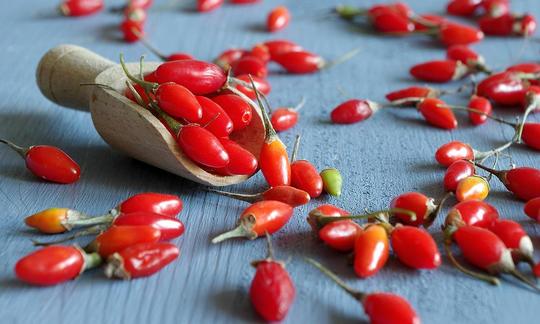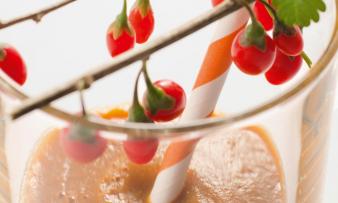Table of contents
The goji berry ( Lycium barbarum), also called Chinese wolfberry or Fructus lycii, has been known as a nutrient-rich berry in traditional Chinese cuisine for centuries.
Use in the kitchen
The elongated wolfberry berries, which are just two centimetres in size, have a coral red colour. They can have a different flavour depending on where they are grown and can taste from sweet to sour, sometimes even bitter. Some people compare the taste to cranberries and cherries, and sometimes also to figs.
Can you eat goji berries raw? Raw goji can be eaten fresh like other berries and can be used to garnish muesli (see, for example , Erb-Müesli). They also taste great as a topping on a salad, including iceberg lettuce with avocado, cherry tomatoes and carrots. Or you can make a goji berry dressing that goes great with apple coleslaw with kale. Together with banana, pineapple or mango and oat drink (or almond milk), you can quickly mix a delicious exotic milkshake. They also go well in a herbal smoothie.
Together with red currants, cranberries, strawberries orraspberries you can make delicious jam or chutney. The berries also go well in vegetable stir-fries, together with yellow bell peppers and zucchini.
In China, where the berries originally come from, the dried berries are mainly used as a topping for soups, rice congee and warm dishes. They are also used in Chinese natural medicine.
Vegan recipe for a tomato-goji gazpacho
Ingredients (for 4 people): 1 kg ripe, red tomatoes, 100 g fresh goji berries, 1-2 cloves of garlic,black pepper, 10 g pine nuts (unroasted).
Preparation: Wash, peel and dice the tomatoes. Peel the garlic cloves. Puree the tomatoes, goji berries and garlic in a blender. Season with pepper. Cover and chill the mixture in the fridge for at least 2 hours. Serve the cold tomato-goji gazpacho in bowls or deep plates. Garnish the vegan gazpacho with the unroasted pine nuts.
Vegan recipes with fresh goji berries can be found under the note: " Recipes that have the most of this ingredient ".
| Not only vegans or vegetarians should read this: Vegans often eat unhealthily. Avoidable nutritional errors. |
Purchasing - Storage
Fresh goji berries are rarely found in the range of large supermarket chains such as Coop, Migros, Denner, Volg, Spar, Aldi, Lidl, Billa, Rewe, Edeka or Hofer. Fresh berries can also rarely be bought in organic supermarkets such as Denn's Biomarkt or Alnatura.
The berries have been grown as a niche product in Europe for several years, which is why you can occasionally buy fresh wolfberries at weekly markets, in farm shops or smaller, regional stores. You can also find suppliers online. Wolfthorn berries are harvested during their main season in open-air cultivation from August to November. 4
Storage tips
Fresh goji berries should be eaten as quickly as possible. Like other berries, they can be stored in the refrigerator for 1-2 days. 3
Ingredients - Nutritional values - Calories
Fresh goji berries (raw) contain 87 kcal per 100 g. The protein content is low at 2.5 g/100g and fat is also almost non-existent at 1.1 g/100g. They contain around 18 g/100g of carbohydrates, of which 11 g is sugar. Wolfberries contain 146 mg/100 g of salt, which is 6.1% of the recommended daily salt intake. 2
Fresh wolfberries contain a lot of vitamin A, at 335 µg/100 g, as RAE. This corresponds to 42% of the daily requirement. 2 Compared to other berries, this is a lot: sea buckthorn berries contain 250 µg/100 g, aronia berries 192 µg/100 g and red sour cherries 64 µg/100 g. 1
It also contains vitamin E. 100 g of fresh goji contains 2.0 mg, which covers 17% of the daily requirement. 2 This is comparable to avocado and raw spinach, both also 2.0 mg/100g, and cabbage 2.3 mg/100g. Nuts have higher vitamin E values, such as almonds (25.6 mg/100g). 1
With their 276 mg per 100 g, goji berries cover around 14% of the daily potassium requirement. 2 Good sources of potassium are herbs, legumes and nuts. Of the fresh fruits , bananas contain 358 mg/100 g and jackfruit 448 mg/100 g. 1
The complete ingredients of fresh goji berries, the coverage of the daily requirement and comparison values with other ingredients can be found in our nutrient tables. In the article Nutrients explained you will get a detailed insight into the topic.
Health effects
Goji berries are sometimes referred to as a "superfood". They are said to be rich in vitamin A, vitamin C and iron. However, the information refers to dried goji berries, as fresh produce was not available outside of China for a long time. Compared to other fruits and vegetables, fresh wolfberries are not unusual, but are comparable to other berries in terms of their nutritional composition.
Do fresh goji berries contain a lot of vitamin A? As mentioned above, fresh berries contain more vitamin A than other berries. However, raw carrots contain more than twice as much vitamin A as fresh wolfberries, at 835 µg/100 g (104% of the daily requirement). 1 More precisely explained (MW): Fresh goji berries contain more carotenoids per 100 g than fresh carrots, but carrots have a much higher proportion of β-carotene. In contrast, goji berries have a dominant proportion of zeaxanthin. However, while β-carotene can theoretically be split into 2 vitamin A units in the small intestine (hence also known as provitamin A), zeaxanthin has only a low vitamin A activity (relative vitamin A activity: β-carotene 100%, zeaxanthin 4.2). Thus, in terms of vitamin A, β-carotene is almost 24 times stronger. But in practice, zeaxanthin is probably even weaker. This ultimately means that our body can produce more vitamin A from 100 g of raw carrots than from 100 g of fresh goji berries.
Do goji berries contain vitamin C and iron? The vitamin C content of the fresh fruit is not unusual at 9.7 mg/100g. 2Blueberries, red sour cherries and plums have comparable vitamin C values. Berries rich in vitamin C, on the other hand, are blackcurrants (181 mg/100g) and sea buckthorn berries (450 mg/100g). 1 The iron content in fresh goji berries is actually relatively low at 0.9 mg/100g (corresponds to 6% of the daily requirement). 2
Dangers - Intolerances - Side effects
Consuming goji berries together with blood-thinning medication is dangerous, as these can increase the anticoagulant effect. 10 Drug interactions with vitamin K antagonists ("Warfar...", "Phenpro..." etc.) can occur. 11
Wolfberries have allergenic potential and can cause cross-allergies with peach, tomato, tobacco, nuts or ragweed. 12 Allergic reactions can also occur in people who have never eaten wolfberries before. 13
High levels of pesticide residues have been found in dried goji berries several times, even in organic products. 20,21 Therefore, preference should be given to those with a European organic label. There have been no studies on fresh goji berries to date.
Folk medicine - natural medicine
In traditional Chinese medicine ( TCM), goji berries are considered to have a yin tonic effect. They are said to nourish the liver and kidneys and strengthen the eyes. 7 In China, Fructus lycii is traditionally used for blurred vision, fever, night sweats, kidney weakness, coughs and asthma, diabetes, heart disease, "weak nerves" and gynecological problems. 17
Ecological footprint - animal welfare
Despite the occasional cultivation of goji berries in countries such as the USA, Brazil, Italy or Poland, the majority of cultivation still takes place in China or other East Asian countries. 22 For consumers in Europe, this means long transport routes and correspondingly high emissions. Fresh goji berries have a very short shelf life compared to dried berries and are sold immediately after harvest. If you find these in stores, they have probably been flown to Europe, which further worsens the ecological footprint. In order to keep the ecological footprint as low as possible, it is best to buy dried goji berries from European production. Individual projects, for example in Portugal, are also committed to more environmentally friendly cultivation of boxthorn, e.g. by using solar energy and reintroducing organic material into production. 23
Due to their high sugar content, goji berries are very susceptible to pests such as mites and aphids, whose infestation can reduce the harvest by up to 25%. To regulate this, pesticides are increasingly being used in China. However, only a small number of pesticides are officially approved, which often leads to the use of unlicensed insecticides and fungicides. 24 Up to 13 different pesticides have been proven to be found on goji berries. 25 Although the values in a random sample test were below the maximum residue levels 22, the purchase and consumption of conventionally grown goji berries is nevertheless not advisable. The use of synthetic pesticides and fertilizers is prohibited in organic farming, so these products are to be preferred to conventionally grown goji berries.
Worldwide occurrence - cultivation
The common boxthorn ( Lycium barbarum L.) and the Chinese boxthorn ( Lycium chinense Mill.) are originally from China. 14 The boxthorn was introduced as a cultivated plant in large parts of Asia (including Tibet, Korea), as well as in Europe, North America, Australia and New Zealand. 15,16,17
Commercial cultivation has so far taken place almost exclusively in China, which is why China is the largest producer of goji berries. 18 However, there are also smaller and larger cultivation areas in Europe (including Portugal 18, Spain 19), the USA and Canada, as well as in Australia and New Zealand. 15,16
Found in the wild
Common boxthorn is a neophyte in Europe as an ornamental and cultivated plant, ie it was introduced by humans, but has since become established and is occasionally found in the wild. 8,9 It is known by the names common boxthorn, common devil's thread, devil's thread or witch's thread.
Cultivation - Harvest
The boxthorn is a fairly undemanding plant and can be easily grown outdoors or in a pot. It prefers a sunny location and well-drained soil. The shrub should be planted with enough space and trimmed regularly so that the leaves can ventilate well. In the first year, boxthorn bushes are only partially hardy, which is why they must be protected from the winter cold with a layer of mulch or leaves. Alternatively, they can be overwintered in an unheated room. From the second or third year onwards, the boxthorn has flowers and fruit. 5
Goji berries are ready for harvest from August or September. In general, you should not pick the fruit from the bush too early so that it tastes sweeter. However, late-ripening berries should be harvested before the first night frost in autumn. 4
Conventionally grown wolfberries are often contaminated with pesticides. That's why organically grown berries are preferable.
Possibility of confusion
The red goji berries are somewhat similar to the elongated, oval fruits of certain wild rose varieties. However, rose hips have many small seeds inside the fruit and the black flower bud is clearly visible at the tip. Goji berries, however, do not have a black tip. 6
Further information
The berries of the common boxthorn ( Lycium barbarum) together with those of the Chinese boxthorn ( Lycium chinense) are known as goji berries. The boxthorn is a plant species within the nightshade family (Solanaceae).
Alternative names
Goji is derived from the Chinese word gǒuqǐ, which means wolfberry. The berries are also known as Chinese wolfberry, Fructus lycii or wolfberry.
Bibliography - 24 Sources
| 1. | USDA United States Department of Agriculture. |
| 2. | Niro S, Fratianni A, Panfili G, Falasca L, Cinquanta L, Alam MR. Nutritional evaluation of fresh and dried goji berries cultivated in italy. Italian Journal of Food Science. 2017 Feb;29(3): 398-408. |
| 3. | Bundeszentrum für Ernährung. Lebensmittellagerung im Haushalt (pdf). |
| 4. | Gartenjournal.net. Goji Beeren aus eigenem Anbau ernten. |
| 5. | Gartenjournal.net. Der ideale Standort für die Goji Beere. |
| 6. | Pahlow M. Das grosse Buch der Heilpflanzen. Gesund durch die Heilkräfte der Natur. Nikol Verlagsges. mbH: Litauen; 2013: 148-150. |
| 7. | Therapeutika.ch. Gou Qi Zi. |
| 8. | Infoflora.ch. Lycium barbarum L. |
| 9. | Floraweb.de. Lycium barbarum L. |
| 11. | PharmaWiki.ch. Goji. |
| 12. | Carnés J, de Larramendi CH, Ferrer A, Huertas AJ, López-Matas MA, Pagán JA, Navarro LA, García-Abujeta JL, Vicario S, Peña M. Recently introduced foods as new allergenic sources: sensitisation to Goji berries (Lycium barbarum). Food Chem. 2013 Apr 15;137(1-4): 130-5. |
| 13. | Larramendi CH, García-Abujeta JL, Vicario S, García-Endrino A, López-Matas MA, García-Sedeño MD, Carnés J. Goji berries (Lycium barbarum): risk of allergic reactions in individuals with food allergy. J Investig Allergol Clin Immunol. 2012;22(5): 345-50. |
| 14. | USDA, Agricultural Research Service, National Plant Germplasm System. 2022. Germplasm Resources Information Network (GRIN Taxonomy). National Germplasm Resources Laboratory, Beltsville, Maryland. |
| 15. | GBIF Backbone Taxonomy. gbif.org. Lycium barbarum L. |
| 16. | GBIF Backbone Taxonomy. gbif.org. Lycium chinense Mill. |
| 17. | Yao R, Heinrich M, Zhao X, Wang Q, Wei J, Xiao P. What's the choice for goji: Lycium barbarum L. or L. chinense Mill.? J Ethnopharmacol. 2021 Aug 10;276: 114185. |
| 18. | EIP-AGRI. Inspirational ideas: European goji berries. |
| 19. | Gojivital.com. Goji-Beere, die Mini-Vitaminbombe. |
| 20. | CVUA Stuttgart. Pestizide in Gojibeeren 2010. |
| 21. | Czech Agriculture and Food Inspection Autority. More than 2 tons dry goji berries from China contained forbidden pesticides Carbofurans. 2017. |
| 22. | Zhang Y., et al. Levels and health risk assessments of pesticides and metals in Lycium barbarum L. from different sources in Nigxia, China. Sci Rep. 2022; 12:561 |
| 23. | Goparity. Goji orchard. 2023. |
| 24. | Chen H, Shen S, Zhi H, Li W. Pesticides residues on Goji berry: A characteristic minor crop in China. Journal of Food Composition and Analysis. 2023. |
| 25. | Der Standard. Lokale Alternativen zum weitgereisten "Superfood". 2018. |









Comments